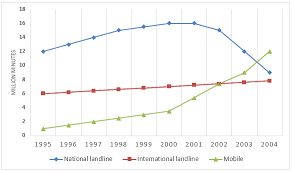You should spend about 20 minutes on this task.
The chart below shows the total volume of telephone calls (in million minutes) in Denmark, divided into three categories, from 1995- 2004. Summarize the information by selecting and reporting the main features, and make comparisons where relevant.
You should write at least 150 words.

Sample Answer
The line graph compares the duration of national landline, international landline and cell phone calls made by citizens of Denmark between 1995 and 2004. Generally speaking, use of mobile phones by Danes increased remarkably after mid-2000 while the use of national fixed lines declined steeply after 2001.
As the diagram suggests, national landline calls made by Danes accounted for almost 12 million minutes in 1995 at which point Danes dialled about 6 million minutes of international calls and less than one million minutes’ call using mobile phones. The duration of conversation made by mobile phones gradually grew till the mid-2000, after which it skyrocketed till the mid-2004. Danes made more than 2 million minutes’ mobile calls during 2000 while it soared to approximately 12 million minutes in the mid-2004. Interestingly, the popularity of mobile phones cut the duration of calls made by the national fixed lines but the use of landlines for international calls slowly rose over the time. During 2004, more than 7 million minutes of international call were made by Danes which was one million higher than that of 1995 using fixed lines. Finally, local landline calls went as high as 15 million minutes in the mid-2001 but after a steady decline it went down as low as 8 million minutes in 2004.
